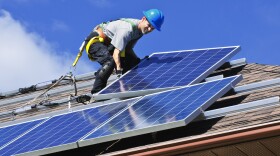Scientists often point to large-scale solar power as a big solution to our climate crisis.
But, these energy projects do come with a cost — the damage and even destruction of our public lands and wildlife.
In a historic move, the Bureau of Land Management has proposed that over 90,000 acres of public lands in Colorado, New Mexico, and Nevada be set aside for solar development.
This would be the single largest solicitation of utility-scale solar energy development to date, with just about 30,000 acres up for grabs in New Mexico. That’s the equivalent of putting solar paneling on one-fourth of Albuquerque.
State Trust Lands, which are mostly open to the public for hunting, fishing, hiking, and other outdoor recreational uses, also house large solar arrays. New Mexico has leased 11 total active projects on these lands across the state, with around 35 more applications for future endeavors coming down the pipeline.
Solar is growing fast in the Southwest. But this has activists like Kevin Emmerich, co-founder of the environmental organization Basin and Range Watch, alarmed about the serious demands solar puts on the landscape.
“They need thousands of acres and they're just removing habitat for several of the iconic desert species like the desert tortoise and the Joshua Tree,” Emmerich said.
Native American cultural sites are also being destroyed, knowingly or unknowingly, by these large-scale utility projects. In California for example, the Genesis solar project in the Mojave desert unearthed many ancestral bones and artifacts that failed to be discovered by an archaeological survey.
And it’s not just solar energy that’s causing these impacts. Emmerich said other renewables, like geothermal and wind, also contribute to the damage of natural springs and bird migratory pathways.
“Well, what do they get out of these remote solar projects? I can’t think of much at all,” Emmerich said.
But there is another option: adding big renewable energy systems to our already existing urban infrastructure.
Emmerich argues solar –– and really, all renewable energy –– needs to be closer to, or even inside, our cities. This, plus the need to cut down on constructing power transmission lines, could reduce the risk of wildfires caused by downed power lines.
President Biden’s administration has made it clear tackling America’s energy woes is a priority, with both an executive order and billions of taxpayer dollars set aside to help. However, this approach relies on utility scale operations like regional hydrogen hubs or large solar projects, which are almost never close to cities.
The solution might just be right over our heads.
Wade Wilson is with Environment America. They conducted a recent study that found we could power nearly 8 million homes across the U.S. by simply putting solar paneling on top of existing big box stores like Wal-Mart or Costco. This, he said, can save money and energy.
“If you’re generating your electricity on top or right next to your home or business, there’s no transmission,” Wilson said.
By some estimates about 5% of our total energy disappears by the time it reaches its destination, sometimes traveling up to hundreds of miles through power lines.
Rooftop solar has already been a standard for some box stores like furniture giant IKEA, which has installed it on 90% of its locations across America. But Wilson said solar shouldn’t stop there.
“Rooftops, parking lots, landfills, and airports,” Wilson said. “Any lot that has already been built, and yet has sunny space… Why not build solar panels there?”
Databases such as the RE-powering mapper from the U.S. Environmental Protection Agency aim to single out urban spaces like these that can be used for renewables of all shapes and sizes.
It works by screening over 130,000 sites that used to be either contaminated lands, landfills, or mine sites and then eyeballing a renewable energy’s potential there.
Though the data is slightly out of date, it shows Albuquerque has around 43 sites for solar energy ranging from the 50,000 acres of land at Kirtland Air Force Base to the top of Winrock Town Center.
This would open up the possibility of microgrids. These are local energy grids that can disconnect from the traditional grid and operate autonomously, providing backup in case of emergencies. Microgrids already exist in places like military bases and hospitals.
Doug Vine is the Director of Energy Analysis at the Center for Climate and Energy Solutions. He said microgrids are very promising for the future.
“There’s some challenges when more and more people put solar on their rooftops with the power flow going in two directions,” Vine said. “So, you do need more sophisticated equipment added to substations and added to local communities and one of those potential solutions is actually fashioning a microgrid.”
This is a shift from the model of relying on large-scale utilities that have traditionally held monopolies and influence like the Public Service Company of New Mexico. But microgrids can be quite expensive to build, and they also face some legal and regulatory hurdles.
Despite these challenges, Vine said some places in New Mexico might be able to pull off big box rooftop solar and microgrids.
“With all the space that is around Albuquerque, and Albuquerque being not as densely populated as some other cities, perhaps in the northeast here where I am, the idea that you can power with more solar sooner certainly makes sense to me,” Vine said. “We’re in a difficult time right now of having to make some tradeoffs with not a lot of time before climate impacts start to get even worse than they currently are.”
Those tradeoffs may include a substantial investment of both time and money to move renewables into urban spaces so we can preserve more public lands.









